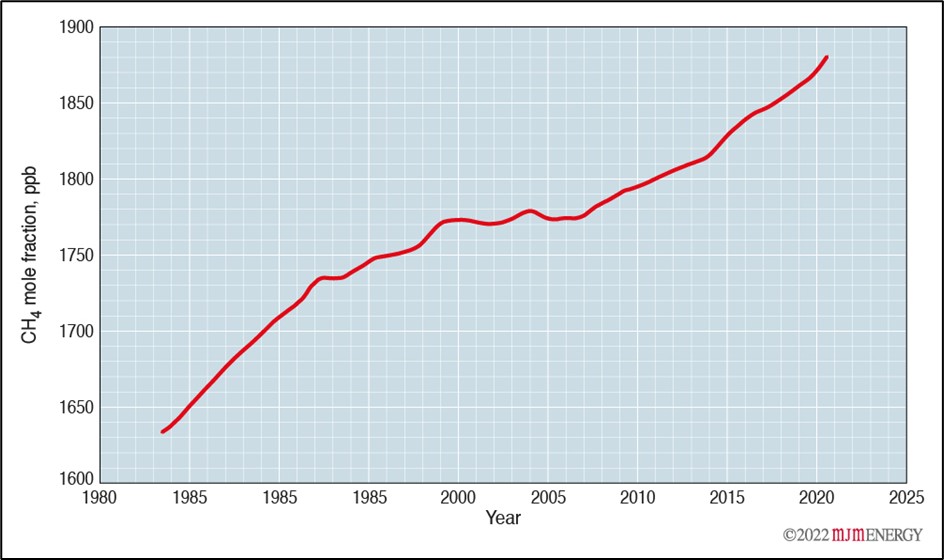Unaccounted for Gas (UFG) in gas network utilities, particularly methane emissions, is a significant yet often overlooked environmental and financial burden. The increasing concern about environmental issues has placed immense pressure on the oil and gas industry to reduce greenhouse gas (GHG) emissions. Methane, a potent GHG with up to 86 times the Global Warming Potential (GWP) of CO2, has garnered attention at COP26, where 105 countries signed the Global Methane Pledge, committing to a 30% reduction in methane emissions by 2030. It is evident that curbing methane emissions from gas networks holds immense potential for making a substantial impact on global climate change goals.
Over the past few decades, methane levels in the atmosphere have been on the rise, with the oil and gas industries ranking as the second-largest anthropogenic source of methane emissions, following agriculture. Methane from the industry primarily enters the atmosphere through venting and unintentional leaks, known as fugitive emissions.
Global Monthly Mean Atmospheric Methane Levels 1980-2020[1]

Unaccounted For Gas (UFG) is responsible of approximately 70 bcm/year of methane release to the atmosphere.
The importance of addressing UFG, especially methane emissions, cannot be overstated due to its dual impact on global warming and financial implications. According to the CEDIGAZ report on “Unaccounted for Gas (UFG) in Gas Network Utilities – An International Perspective” approximately 1.75% of the global natural gas demand annual demand is attributed to UFG, with an estimated 50% representing methane emissions released into the atmosphere. This represents approximately 70 bcm/year of methane release to the atmosphere. Considering methane’s significant Global Warming Potential, reducing UFG becomes paramount in the battle against global warming. The Global Methane Pledge highlights that a 30% decrease in methane emissions could potentially lower global warming by 0.2°C. Additionally, UFG leads to substantial financial losses for utilities and imposes additional costs on customers, amounting to billions of dollars. Consequently, there exists a compelling financial incentive to address and reduce UFG.
Against the backdrop of growing environmental initiatives to combat methane emissions from gas network utilities, the CEDIGAZ report delves into the sources and quantification of UFG, providing a comprehensive overview of methane emissions worldwide. The report further focuses on UFG resulting from the activities of gas network utilities, exploring potential causes and associated solutions related to leakage, Own Use Gas (OUG), theft, and measurement errors. It also investigates the role of gas market regulators in measuring, monitoring, and reducing UFG from gas network utilities. Concluding the report is an extensive review of current data and estimates on UFG from gas network utilities in 82 countries, with results presented regionally and globally.
The report underscores the immense potential for significant methane emissions reduction within the oil and gas industry, particularly in the areas of gas flaring and venting. Cost-effective measures can be implemented to address these issues. Key strategies include:
- Accurate measurement of flared and vented gas: Establishing systems and procedures to precisely quantify current losses from flaring and venting is crucial, as the availability of good quality data remains limited even in 2022.
- Active monitoring of reduction: Improved measurement of flared and vented gas would enable the industry and regulators to actively monitor progress and publish transparent reports showcasing the reduction achieved.
- Monetization of flared and vented gas: Encouraging companies to utilize excess gas can significantly reduce venting and flaring activity. Options include diverting gas to nearby gas markets or using it for on-site electricity generation, which can be utilized or sold to the grid. Compression for Compressed Natural Gas (CNG) or small-scale liquefied natural gas (LNG) trains are also viable alternatives.
- Effective regulations: Regulations that limit venting and flaring activities are already in place in various regimes. However, careful implementation is necessary.
Unaccounted for Gas (UFG) in Gas Network Utilities – An International Perspective – A report by MJMEnergy for CEDIGAZ – PDF – 155 pages
Pricing: €999 for CEDIGAZ members – €1.999 for non-members
(Orders made before 31st August 2023 will receive a 20% discount)
